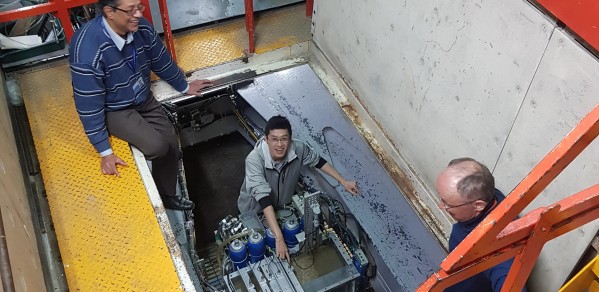
A presentation by PhD student Diarmid Xu on the response of rock-scour protection to earthquake induced liquefaction for offshore wind applications, has won the Cooling Prize.
Offshore wind generation is an ever-growing industry that is key to meet the future demands of renewable electricity generation. Many of the new wind farms being constructed are in regions that are both seismically active, and scour prone, such as East Asia and North America.
Diarmid Xu
The British Geotechnical Association (BGA) awarded the 54th Cooling Prize to Diarmid. BGA executive committee member Nicholas Armstrong who was chair of the judging panel, said that Diarmid’s presentation on the design of monopiles for offshore wind farms was particularly interesting given that “issues that designers are facing are increasing and the cost of long term maintenance of those assets are really significant”. He added that the presentation was “beautifully presented”, and he praised Diarmid’s approach to his research.
Diarmid gives a summary of his PhD project below:
Offshore wind generation is an ever-growing industry that is key to meet the future demands of renewable electricity generation. Many of the new wind farms being constructed are in regions that are both seismically active, and scour prone, such as East Asia and North America.
Currently there is very limited data or research in the behaviour of these scour protection rocks under seismically induced liquefaction. We expect, and have seen significant rock settlements, even with a medium strength earthquake, so this is a key area of active research.
What is liquefaction?
Loose sandy soil is a common seabed condition. When an earthquake hits, the shaking will disturb and mix the sand grains with seawater, creating a non-Newtonian, strength-less mixture. This process is called liquefaction and could cause all sorts of problems for offshore foundations, such as excessive settlements and/or rotations.
What is scour in offshore wind?
Scour is a phenomenon whereby the redirected water currents from a foundation create vortices which wash away the sediment surrounding the foundation, as observed commonly around bridge piers. To combat or remediate this, the most common method is rock dump. Large quantities of rocks are dropped from barges around each foundation. The lower filter layer of smaller rocks is there to reduce rock settlement due to self-weight, and a top layer of armour rocks, larger boulders that resist the force of water.
Currently there is very limited data or research in the behaviour of these scour protection rocks under seismically induced liquefaction. We expect, and have seen significant rock settlements, even with a medium strength earthquake, so this is a key area of active research.
Centrifuge testing:
Most civil engineering structures, such as building or dams, are too large and thus prohibitively expensive to carry out scale testing. To properly study the non-linear behaviour of soils, geotechnical centrifuge testing is used. If we “shrink” down our structure of interest, for example, to one one-hundredth of its real-life size, but carry out testing at one hundred times earth’s gravity, on the centrifuge, mathematically we can scale our experimental results back up to life scale.
The project uses the 10m diameter Turner Beam Centrifuge at the Geotechnical and Environmental Research Group's Schofield Centre, to simulate a variety of earthquakes on a range of rock berm foundations. In addition to recording settlements, accelerations and water pore pressures, high speed photography was also deployed to capture the flow of rocks and sand.
The results show significant rock settlements even under medium strength earthquakes, but by changing the rocks that make up the berm, it is possible to reduce the loss of rock. The project aims to both better understand the factors governing the movement of rock, and to make suggestions for the design and construction of future scour protection rock berms to make them more resilient to seismic liquefaction.
Diarmid's research project was sponsored by water challenge specialists HR Wallingford. Diarmid's supervisor Professor Gopal Madabhushi says: "Scour protection around offshore foundations using rock berms is vulnerable to soil liquefaction. HR Wallingford were interested to know how much of the rock berm they will lose after a strong earthquake. Diarmid’s work is aimed at clarifying the fundamental mechanisms at work when large rocks start to sink into liquefied ground."
Diarmid will now be invited to write up his presentation as a technical paper for publication in Ground Engineering magazine and will also be invited to give the presentation to the BGA’s Annual Conference later in the year.
The Cooling Prize finalists’ poster presentations were followed by a keynote lecture by Cardiff University’s Professor of Civil Engineering Snehasis Tripathy on “Climate change - Challenges ahead for geotechnical engineers”.
The Cooling Prize competition is held annually by the BGA and is intended for professionals in the geotechnical/ground engineering industry in the early stages of their careers.

